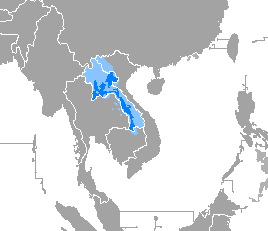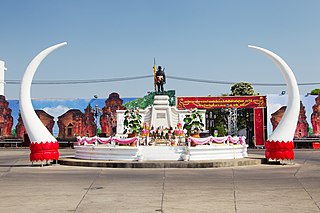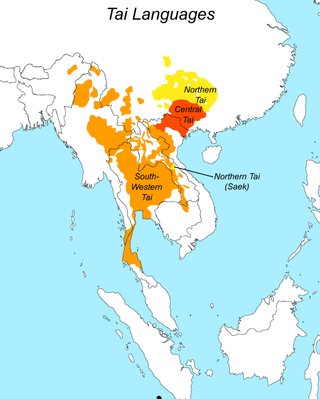
Demographic features of the population of Cambodia include population density, ethnicity, education level, health of the populace, economic status, religious affiliations and other aspects of the population.

Evidence of modern human presence in the northern and central highlands of Indochina, which constitute the territories of the modern Laotian nation-state, dates back to the Lower Paleolithic. These earliest human migrants are Australo-Melanesians—associated with the Hoabinhian culture—and have populated the highlands and the interior, less accessible regions of Laos and all of Southeast Asia to this day. The subsequent Austroasiatic and Austronesian marine migration waves affected landlocked Laos only marginally, and direct Chinese and Indian cultural contact had a greater impact on the country.

Laos is a country in Southeast Asia. The country's population was estimated at about 7.43 million in 2021, dispersed unevenly across the country. Most people live in valleys of the Mekong River and its tributaries. Vientiane Prefecture, which includes Vientiane, the capital and largest city of the country, had 820,924 residents as of the 2015 census. The country's population density is 26.7/km2.

The demographics of Thailand paint a statistical portrait of the national population. Demography includes such measures as population density and distribution, ethnicity, educational levels, public health metrics, fertility, economic status, religious affiliation, and other characteristics of the populace.

Lao, sometimes referred to as Laotian, is the official language of Laos and a significant language in the Isan region of northeastern Thailand. Spoken by over 7 million people in Laos and 23 million in Thailand, it serves as a vital link in the cultural and social fabric of these areas. It is written in the Lao script, an abugida that evolved from ancient Tai scripts.

The Lao people are a Tai ethnic group native to Southeast Asia, who speak the Lao language of the Kra–Dai languages. They are the majority ethnic group of Laos, making up 53.2% of the total population. The majority of Lao people adhere to Theravada Buddhism. They are closely related to other Tai people, especially with the Isan people, who are also speakers of Lao language, native to neighboring Thailand.

Northeast Thailand or Isan consists of 20 provinces in northeastern Thailand. Isan is Thailand's largest region, on the Khorat Plateau, bordered by the Mekong River to the north and east, by Cambodia to the southeast and the Sankamphaeng Range south of Nakhon Ratchasima. To the west it is separated from northern and central Thailand by the Phetchabun Mountains. Isan covers 167,718 km2 (64,756 sq mi), making it about half the size of Germany and roughly the size of England and Wales. The total forest area is 25,203 km2 (9,731 sq mi) or 15 percent of Isan's area.

Surin is one of Thailand's seventy-seven provinces (changwat). It lies in lower northeastern Thailand, also called Isan. Neighboring provinces are Buriram, Maha Sarakham, Roi Et, and Sisaket. To the south it borders Oddar Meancheay of Cambodia. Surin covers a total area of 8,124 km2 (3,137 sq mi) from the Mun River in the north to the Dangrek Mountains in the south. The capital, Surin city, in the western central region province is 434 km from Bangkok.

The history of Isan has been determined by its geography, situated as it is on the Korat Plateau between Cambodia, Laos, and Thailand.

Laos developed its culture and customs as the inland crossroads of trade and migration in Southeast Asia over millennia. As of 2012 Laos has a population of roughly 6.4 million spread over 236,800 km2, yielding one of the lowest population densities in Asia. Yet the country of Laos has an official count of over forty-seven ethnicities divided into 149 sub-groups and 80 different languages. The Lao Loum have throughout the country's history comprised the ethnic and linguistic majority. In Southeast Asia, traditional Lao culture is considered one of the Indic cultures.

Thai people, Chao Phraya Thai, Central Thai people, Southern Thai people, Siamese, Thai Siam, Tai Noi people, are a Southeast Asian ethnic group native to Thailand. In a narrower sense, the Thais are also a Tai ethnic group dominant in Central and Southern Thailand. Part of the larger Tai ethno-linguistic group native to Southeast Asia as well as Southern China, Thais speak the Sukhothai languages, which is classified as part of the Kra–Dai family of languages. The majority of Thais are followers of Theravada Buddhism.
The Lao Nyaw, Thai Nyaw or Tai Yo are an ethnic group of Thailand, Cambodia and Laos, scattered throughout the provinces of Isan such as Nong Khai, Sakon Nakhon, Nakhon Phanom, and parts of Bolikhamxai and Khammouan provinces of Laos. They are also referred to as simply Nyaw or Yaw, depending on either the Lao, Isan, and Nyaw pronunciation, which all pronounce the initial consonant as, or the Thai pronunciation, which pronounces the initial consonant as.

The largest of the ethnic groups in Cambodia are the Khmer, who comprise 95.8% of the total population and primarily inhabit the lowland Mekong subregion and the central plains. The Khmer historically have lived near the lower Mekong River in a contiguous arc that runs from the southern Khorat Plateau where modern-day Thailand, Laos and Cambodia meet in the northeast, stretching southwest through the lands surrounding Tonle Sap lake to the Cardamom Mountains, then continues back southeast to the mouth of the Mekong River in southeastern Vietnam.

The Phuan people, ພວນ Phouan, pronounced[pʰúa̯n]), also known as Tai Phuan, Thai Puan or Lao Phuan, are a Theravada Buddhist Tai people spread out in small pockets over most of Thailand's Isan region with other groups scattered throughout central Thailand and Laos. There are also approximately 5000 Phuan in the Mongkol Borei District of Banteay Meanchey Province in Cambodia, as well in Battambang Province. According to the Ethnologue Report, the Phuan number 204,704 and that is split fairly evenly between populations in Laos and Thailand.
Phuan or Northeastern Lao is a Tai language spoken in Laos, Thailand and Cambodia.

Thailand is home to 71 living languages, with the majority of people speaking languages of the Southwestern Tai family, and the national language being Central Thai. Lao is spoken along the borders with the Lao PDR, Karen languages are spoken along the border with Myanmar, Khmer is spoken near Cambodia and Malay is spoken in the south near Malaysia. Sixty-two 'domestic' languages are officially recognized, and international languages spoken in Thailand, primarily by international workers, expatriates and business people, include Burmese, Karen, English, Chinese, Japanese, and Vietnamese, among others.

Tai peoples are the populations who speak the Tai languages. There are a total of about 93 million people of Tai ancestry worldwide, with the largest ethnic groups being Dai, Thais, Isan, Tai Yai (Shan),Tai Lai(Shanni), Lao, Tai Ahom, Tai Meitei and Northern Thai peoples.

The Kuy are an indigenous ethnic group of mainland Southeast Asia. The native lands of the Kuy range from the southern Khorat Plateau in northeast Thailand east to the banks of the Mekong River in southern Laos and south to north central Cambodia. The Kuy are an ethnic minority in all three countries, where they live as "hill tribes" or Montagnards. Their language is classified as a Katuic language of the Mon-Khmer language family. The Thais, Lao, and Khmer traditionally recognize the Kuy as the aboriginal inhabitants of the region. The word kuy in the Kuy language means "people" or "human being"; alternate English spellings include Kui, Kuoy and Kuay, while forms similar to "Suay" or "Suei" are derived from the Thai/Lao exonyms meaning "those who pay tribute". The Kuy are known as skilled mahouts, or elephant trainers, and many Kuy villages are employed in finding, taming, and selling elephants.
The people of Laos have a rich literary tradition dating back at least six hundred years, with the oral and storytelling traditions of its peoples dating back much earlier. Lao literature refers to the written productions of Laotian peoples, its émigrés, and to Lao-language works. In Laos today there are over forty-seven recognized ethnic groups, with the Lao Loum comprising the majority group. Lao is officially recognized as the national language, but owing to the ethnic diversity of the country the literature of Laos can generally be grouped according to four ethnolinguistic families: Lao-Tai (Tai-Kadai); Mon-Khmer (Austroasiatic); Hmong-Mien (Miao-Yao), and Sino-Tibetan. As an inland crossroads of Southeast Asia the political history of Laos has been complicated by frequent warfare and colonial conquests by European and regional rivals.

















